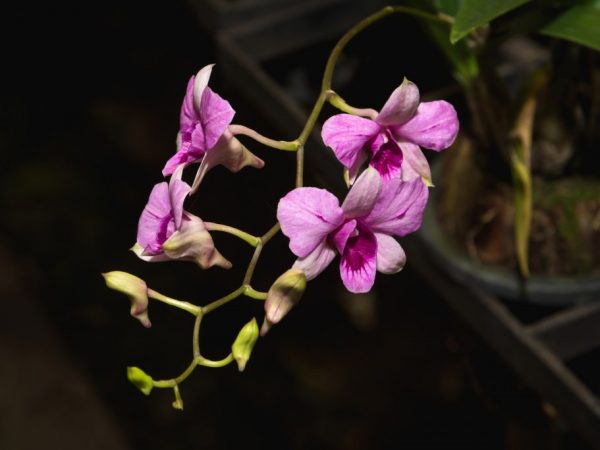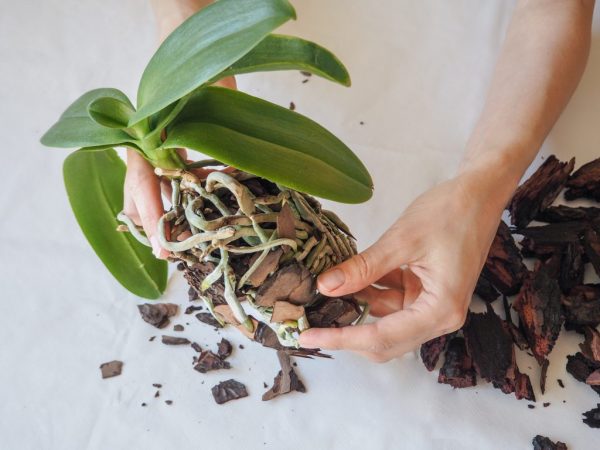Caring for dendrobium Nobile after flowering
Proper care of dendrobium nobile after flowering is the key to good plant growth and development. It is worth considering all the features of the orchid when choosing a strategy for caring for it during the dormant period.

Caring for dendrobium Nobile after flowering
Transfer
After the end of the flowering process, the dendrobium orchid in some cases needs to be transplanted. To determine the need to change the pot, you need to carefully examine the condition of the soil and the leafy part of the houseplant.
Planned
Transplanting dendrobium nobile after purchase is carried out once. Frequent transplanting can harm the plant, because this type of orchid is very sensitive to a change in scenery.
At home, it is worth considering the maturity of Dendrobium Nobile. Choose plants with already matured and grown pseudobulbs. It is allowed to change the soil no earlier than after 2 years from the moment when the orchid faded for the first time.
Emergency
There are cases when landing at a new location is extremely necessary as soon as possible. This should be done if:
- the substrate in the container has undergone alkalization after regular irrigation with water with a high percentage of hardness;
- root shoots are damaged, dried or rotten areas;
- a white veil of cobwebs or a sticky coating left by various pests appeared on the vegetative part of the plant.
In this case, changing the soil composition will be a good prevention or help save the orchid from parasites.
Transplant rules

Plant health depends on proper planting.
In order for the plant to adapt well, the transplanting process should be carried out correctly. At home, this is done like this:
- Prepare the substrate that is optimal in terms of composition. It should include pine bark or coconut chips, sphagnum moss and charcoal.
- Disinfect the substrate by calcining in an oven at a temperature above 90 ° C.
- Choose a sturdy clay pot with good air exchange. The plant must fit freely in a new location.
- Disinfect tools for pruning roots with an antiseptic.
- Rinse the dendrobium root system with running water at room temperature.
- If damage is present, treat with a fungicide or other disinfectant.
- Allow to dry well before planting. The average drying time is 7-9 hours.
- Drain and add some fresh substrate to the bottom of the pot.
- Place the orchid gently without dipping the young bulbs too deep.
After transplanting, protect the plant from moisture for 5 days. Continue with your usual care.
Pruning after flowering
Pruning a plant that has faded is carried out in 2 cases. Firstly, if the shoots have begun to dry out, then removal will contribute to less waste of nutrients on the parts of the orchid that are not capable of vegetation.
Secondly, leaves and root processes affected by parasites and diseases are subject to destruction. Pruning a diseased pseudobulb is carried out as carefully as possible.Do not touch the rest of the areas, as this will lead to the movement of the disease to the healthy parts of the indoor flower.
If there are live green buds on the sprouts that have not bloomed before, do not disturb the plant with pruning. Do not remove the bulbs unnecessarily, because they accumulate nutrients necessary for full development.
Watering
After the flowering period, it is worth minimizing the moisture intake. In the cold season, completely exclude the introduction of liquid for 2-2.5 months. In hot summer, the plant requires more moisture, so the amount of water for irrigation is doubled.
Watering after the dendrobium has faded, should be carried out using the methods of immersion and surface irrigation, but only after the soil has completely dried out.
The Nobile orchid watering liquid is used warm, the temperature of which should not be lower than 25 ° C.
If pseudobulbs begin to wrinkle from lack of moisture, sprinkle them with warm water.
Temperature regime
Dendrobium Nobile is able to grow in extreme conditions, the temperature regime in which can vary from 0 ° to 40 ° C. However, maintain the optimum air temperature for regular flowering and better growth. It should not be below 20 ° C. A slight decrease at night stimulates the development of new peduncles and creates favorable conditions for the normal functioning and production of nutrients during the process of photosynthesis. A decrease of 4–6 ° C is considered optimal.
In winter, contrast the temperature for the orchid by transferring it to a room with medium humidity and a thermometer reading of about 14-15 ° C. In general, the rest period is kept at room temperature of about 23 ° C. Keep adequate indoor lighting throughout the winter.
Fertilizers
After the dendrobium has faded, it needs to be fully fertilized. A feature of the Nebulo orchid is that at home, feeding is carried out for root shoots. Balanced complexes are applied from early summer to autumn during the growth phase. Systematic fertilization will accelerate development and contribute to the full formation of new bulbs. For this purpose, it is better to apply mineral nitrogen fertilizers, but in general this species is unpretentious to the composition of the dressings.
Conclusion
Caring for dendrobium nobile after flowering will give the plant new strength for growth and development. The orchid will bloom regularly in the future, and will also become more resistant to diseases and pests.


